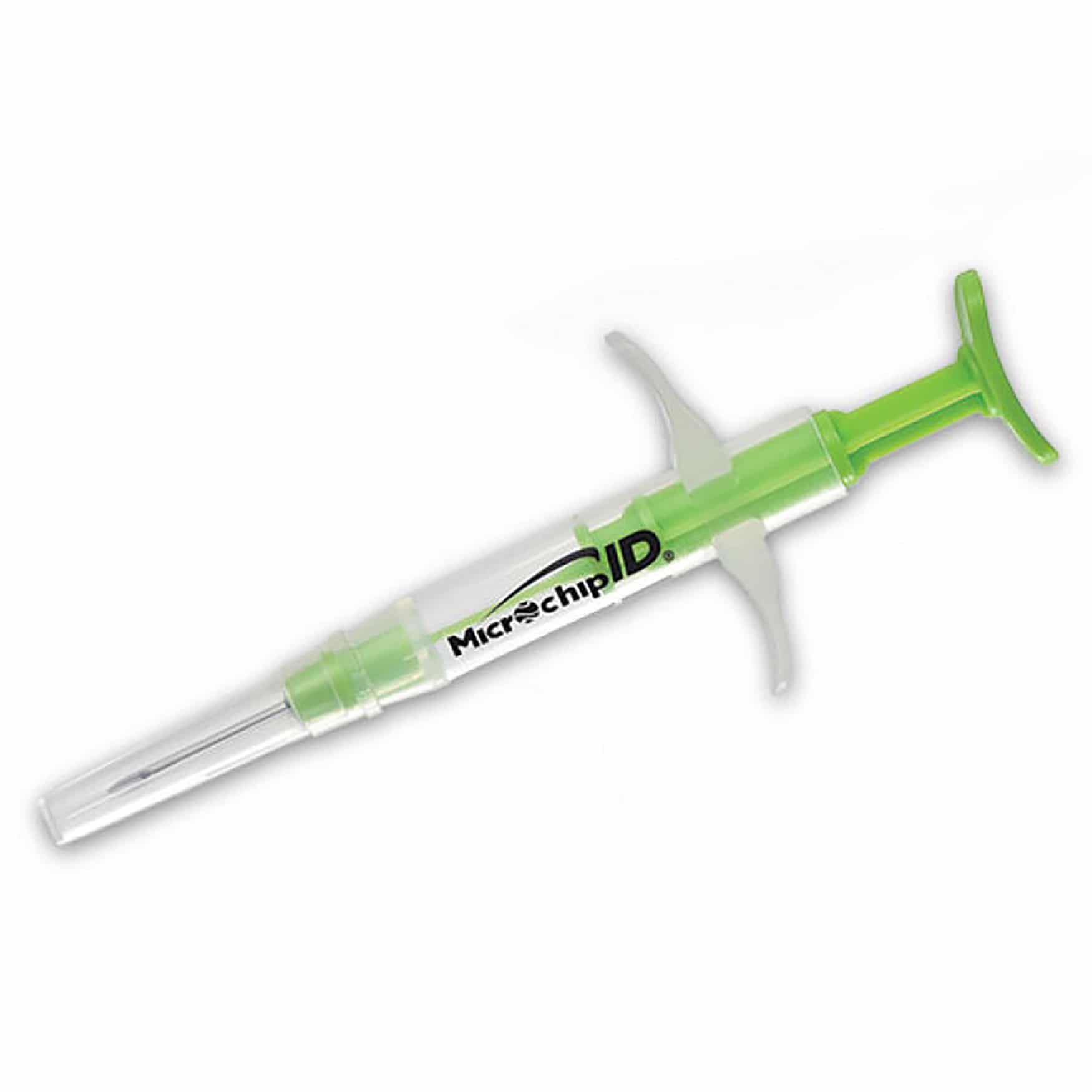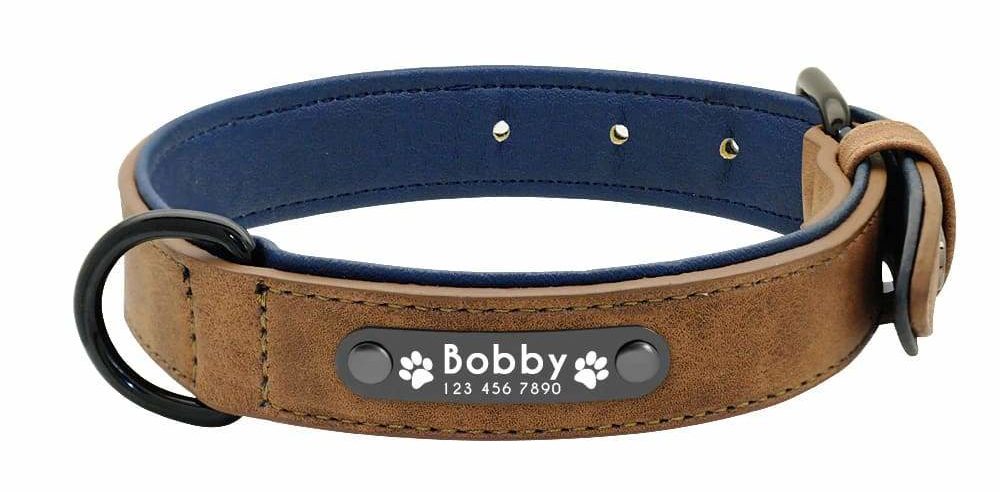This information is not intended to provide veterinary advice – see your veterinarian for information and treatment plans for your pet.

Each year, about 10 million pets are lost around the country. Without a microchip or ID tag, only 15 percent of dogs and two percent of cats will make it back home to their families.
A microchip is the most reliable way to make sure your pets return home if they get lost. An ID tag and/or collar with your phone number will allow someone who finds your pets to quickly return them to you without needing to find a microchip scanner. The combination of these two tools gives your pets the best chance of returning to you if they are ever lost or stolen.
A microchip is a small electronic chip (about the size of a grain of rice) that is implanted under the loose skin between your pet’s shoulder blades. Your pet’s chip emits a radio frequency with a unique ID number that can be detected by a scanner. The manufacturer of your microchip has a database with your pet’s ID number and your owner contact information so they can contact you if your pet is ever lost. A microchip is not a GPS and cannot help you find where your pet has gone.
Microchips help you and your pet reunite if your pet gets lost. Unlike collars, microchips won’t fall off, so anyone with a scanner can find your pet’s unique ID number. The chip manufacturer maintains owners’ contact information and can contact you to reunite you with your pet.
If your address, phone number or email address changes after you register your pet’s microchip, it is very important to call the chip manufacturer to update the information. If ever your pet is stolen, this will also help you to prove that you are the rightful owner. Watch Max’s story to see how microchips reunite pets with owners.
If your address, phone number or email address have changed, it’s important to update this information with your microchip manufacturer. The chip number and manufacturer is usually noted on adoption papers and on veterinary records. Although there are many databases, the first one that most veterinarians and rescue organizations will check is the one belonging to the chip manufacturer.
If you are not sure which company made your pet’s chip, you can look at the American Animal Hospital Association’s Universal Microchip Lookup Tool to get the information.
Most veterinary offices and some animal rescue organizations and pet stores have microchip scanners and will scan found pets for free during their standard business hours. If you find a lost pet at night or on the weekend when some organizations are closed, contact local 24 hour animal hospitals to see if they can scan the pet.
Many lost pets are found very close to home. If they are wearing an ID tag or collar, the finder can reach you more quickly. If your pet has no ID tag, the person who finds your pet will have to go somewhere with a microchip reader so they can scan to see if there is a chip. If the finder doesn’t know where to find a chip scanner or can’t go right away, it may take longer to get your pet back home. Sometimes ID tags or collars can come off, so having the combination of the ID tag and the microchip creates more ways for your pet to be reunited.
Always update your pet’s microchip when there is a change in your contact information or if you are preparing to travel, board your pet, or experience an emergency, such as a hurricane or flood. If you adopt or have to rehome your pet, be sure the new information is added. National Check the Chip Day is August 15, so this is also a great time to make sure your dogs and/or cats have up-to-date information. Some microchips require an annual renewal fee, so be sure to check with your microchip manufacturer to know what they require.
Pet owners often provide their dogs or cats with collars for identification or to prepare for exercise activities, such as going for walks. Tethers are sometimes used to temporarily restrict pets’ movement. In both cases, it is important to select options that are safe and size-appropriate for your pet.
As of January 18, 2022, the Safe Outdoor Dogs Act will make it illegal for Texas dog owners to tie up pets with chains or weighed-down restraints.
Many people who chain or tether their dogs do so for long periods of time, leaving them alone in the yard with no time to run around or interact with the family. Dogs need to exercise and connect with their “pack” – the humans and animals that make up their family. Because of the physical and psychological harm caused by chaining, many states, like Texas, have created laws to stop this practice.
If you need to tether your dog, do so for short periods of time, ideally while you are supervising him or her.
Rather than tethering your dog, think about what problems make you want to tie the dog outside to start with and then work to fix those.
If there is no fence, there may be other options to help provide confinement for your pet without the need for a chain, such adding a fence or a large outdoor kennel with a shaded top. If the dog climbs the fence, you can extend the height by adding fencing or other materials to make it taller and harder to climb. If your pet is digging under the fence, you can bury chicken wire/wire fencing or add bricks or concrete blocks along the edge to stop this behavior.
If you want the dog outside because he is chewing on household items or is having accidents, some behavior training can help with this. If the dog has fleas or other parasites, baths and/or medication could solve the problem.
The National Humane Education Society has outlined several risks associated with chaining or tethering, including strangulation, inability to get away if animals or people try to cause harm, exposure to extreme weather and parasites, boredom that leads to bad or aggressive behavior, and more.
It is best not to keep dogs tethered, if possible. If you need to tether your dog, select a tether that is an appropriate size and weight for your dog and leave them out for short periods of time, ideally while you are supervising. Make sure there is nothing nearby that the tether can get caught on (like a tree, pole, furniture, etc.) as your dog could get wrapped up in the tether near these items and choke. Also make sure your dog cannot knock over the water bowl as pets must always have access to clean, fresh water.
Some tie out cables are made of plastic coated steel cables, which manufacturers claim to be chew proof. If you are trying a new tether, monitor your pet closely to make sure they are safe and not chewing on the cable.
There are people and organizations that may be able to help pet owners stop tethering dogs by providing help for fencing or kennels. Contact rescue groups listed in local resources to see if they can assist or complete an inquiry form on the Contact Us page.
Check the Get Help page for resources on low-cost veterinary care or training if these will help correct the problems that lead you to tether your dog.
You should check the fit of your pet’s collar regularly to ensure it is not too loose where they could slip out of it or too tight (the general rule is you should be able to fit two fingers in the collar). Collars that are too tight can cause hair loss or can become embedded in your pet’s skin, sometimes requiring painful surgery to remove it.
The neck is a sensitive area for our pets. Owners must take care when pets pull on their collars as this can hurt their necks or make it hard for pets to breathe. If your pet regularly pulls while walking on leash, you can switch to a chest harness or “correction collar” (such as a martingale). You can also train your pet to help them learn how to walk on leash.
You should check the fit of your pet’s collar often, especially if you have a growing puppy or kitten or a dog that could be gaining or losing weight (due to illness, pregnancy, changes in eating habits, etc.). The general rule is that you should be able to slip two fingers under the collar, but this may vary depending on your pet. Make sure the collar is not too loose to slip off or too tight to cause hair loss, dig in their skin or make it hard to breathe.
Breakaway collars are designed to prevent cats or dogs from getting caught on something that could choke them – a fence, the mouth of another animal, etc. When pressure is applied, the collar is designed to release and fall off. These collars are most commonly used for outdoor cats. Many even come with reflective surfaces and the ability to customize the collar to include your phone number so your pet has identification.
This type of collar is not intended for use when walking pets unless it has a double ring feature where you attach the leash to the two rings on either side of the breakaway buckle. This way, even if your dog pulls, the breakaway feature won’t be activated. If you use the double ring breakaway collar, please be careful to use it correctly so your pet cannot escape.


Greater Houston is known to get flooding rains, tropical storms or hurricanes on a regular basis. Although we often have some time to plan for these events, other types of emergencies could arise with no warning, such as a house fire, auto accident, or even death.
Although no one likes to think about these situations, it is important that we have plans for our pets’ care if an emergency strikes.
Sadly, there are many types of emergencies that can impact pet owners. Some events, like hurricanes, floods and tornadoes, can include some advance warning through weather forecasts. Even thunderstorms and holidays celebrated with fireworks can create emergencies for our pets who often become stressed by the noise, leading some to try to escape and hide. Other emergencies, like household fires, auto accidents or deaths may have no advance warning.
That’s why it is important to think through what type of emergencies may impact your ability to care for your pets and have a plan to make sure your cats and/or dogs are safe and protected.
Create a plan for a friend, neighbor or family member to watch your pets if you are unable to get home due to an accident, medical emergency or weather event.
Many pet owners have keychains that say “My Pet Is Home Alone, See Purse or Wallet for Contacts” to help alert first responders about pets. Make sure your phone has a listing for “ICE” (In Case of Emergency) and that your contact knows how to help your pets if you cannot.
Make sure you have an immediate plan for your pets (see above “How do I protect my pets if I live alone and am in an accident?”). It is also important to have a long term plan about who will take your pets.
Many owners assume their family will take their pets, but each year hundreds of pets are taken to shelters when family members cannot or do not want to keep the pets. Talk to your friends to find someone you trust to adopt or rehome your pets. Protect My Pet is a local Facebook group for elderly or terminally ill pet owners who are looking for help finding a new home for their pets.
If possible, include pet care information in your will. Some owner also include money to help provide for their pets’ supplies and veterinary needs.
Review emergency preparedness information and make a plan. Ideally, you have leashes and/or carriers/kennels for each pet that you could use in an emergency. Even if your pet is normally calm and well behaved, in an emergency, they will also be scared and could try to run away. Having them in a pet carrier is safest for you and them.
In addition to having your pet microchipped, make sure your pets are wearing an ID tag or collar with your phone number. Be prepared to take your recent veterinary records showing they are up-to-date on vaccinations, as this may be required if you seek assistance from an emergency shelter or pet boarding facility. Also, make sure you have at least a few days worth of food and any medications required.
Because 95 percent of people view their pets as family, many owners refuse to leave pets behind in an emergency. When people refuse to evacuate when it has been ordered, this places the owner, pets and first responders at risk. This has caused many communities to include pets in their emergency plans, making it easier for residents to safely evacuate with their beloved pets. Although some shelters are not prepared to accept pets, Red Cross can be a valuable resource for getting information on shelters or pet-friendly evacuation options.
Many of the national hotel sites such as airbnb.com, Booking.com, Expedia.com, Hotels.com, and trivago.com allow site visitors to filter or search amenities for “pet friendly” options.
In addition, some sites specialize in searches for pet-friendly travel, including:
BringFido (listings of pet-friendly hotels, restaurants and more)
DogFriendly.com (pet-friendly hotels, bed & breakfasts and lodging)
GoPetFriendly (pet-friendly lodging, restaurants, activities and services)
PetTravel (pet friendly hotels, airline pet policies, travel products, and more)
According to the American Red Cross, the National Fire Protection Association indicates pets start hundreds of home fires each year. To reduce the chances of this happening in your home, blow out candles or flames in cooking appliances or fireplaces when you are not monitoring them. If you leave pets loose in your home while you are away, remove or cover stove knobs so they cannot jump up and accidentally turn on the appliance – the most common way pets start fires in homes.
Also beware of placing clear glass water bowls outside on wood surfaces, such as a deck. The sun can beat down and the bowl acts like a magnifying glass heating the area below until it can start a fire.
For more suggestions, visit the American Red Cross Pet Fire Safety Plan.
Some dogs will fight to defend their territory or other resources, such as food, puppies or their mates. That is one of the many reasons why it is important to follow laws about keeping dogs on leashes or in fenced yards. Although most communities allow cats to roam freely, they will also fight for these reasons.
Whether these are owned pets or community cats, it is important to protect animals by trying to provide enough resources to where they don’t need to fight – multiple water bowls, feeding stations or shelters. If providing toys or enrichment items at home, make sure there are enough for each pet to have their own and monitor their play and body language to make sure they are relaxed and playing nicely together.
Consider separating pets during feeding and play time, especially if one is new to the household or is dominating the other.
If you are helping community cats, if possible, provide multiple water bowls, feeding stations or shelters to lessen the likelihood they will fight over limited resources.
Dogfighting is illegal in the United States. Violations can lead to a felony conviction, three years of jail time and a fine of $250,000. Even having dogs for fighting can be a felony. Dogs experience fear and pain, so allowing them to fight is cruel and must not be encouraged or ignored.
It’s not just owners who can get in trouble for dogfighting. Watching a dog fight in Texas is illegal. Allowing dogs to fight on your property, training a dog to fight, owning dogfighting equipment to teach dogs to fight, or receiving money for dog fights are all illegal. Dog fighting is cruel and should not be encouraged or supported in any way.
People who are involved in dogfighting are often involved in other crimes, so it is important to take dogfighting seriously and report it to authorities. Visit the Get Help – Cruelty section to find information on where to report suspected cruelty. You can even remain anonymous!


Although Texas does not have a law against pets being off leash, many communities do. Make sure you know and follow the rules. Even if your community does not have rules against roaming pets, allowing owned dogs and cats to freely roam can be dangerous and may lead to unwanted litters of puppies or kittens if pets have not been spayed or neutered.
Most communities have ordinances that prevent pets from being off leash. Even if your dog is normally well behaved, dogs have strong prey drives and can suddenly run into the street to chase a cat or squirrel.
Also, other dogs on leash may not be as well behaved or friendly, and if the dogs get into a fight, you have no easy way to separate them without putting yourself at risk. It’s best to be safe, and to stay in compliance with ordinances.
In addition to following local ordinances, there are many practical reasons not to let your pet roam the neighborhood. Drivers are more distracted than ever. Your pet is at risk for being hit by a car, which is painful (or deadly) for them and expensive for you. In addition, pets could be hurt by other animals guarding their territory, by other people or by wildlife such as wild boars or coyotes, which have been seen in cities and rural areas.
Sadly, many pets in Greater Houston are found each year with wounds from bullets, buckshot, knives, arrows and blunt force trauma. Pets can die of shock, blood loss or infection. Treatment costs vary, but can reach into the thousands to treat severe injuries.
Pets could also wander into places where there are poisonous items that could hurt them, such as antifreeze, fertilizers and other chemicals and pesticides. Even water puddles that collect after heavy rains can have harmful chemicals or wildlife.
Pets could also become protective of their territory and harm a person or animal. As the owner, you are responsible for these injuries and, most likely, all costs associated with them.
Finally, many pets wander to find sex. Greater Houston has thousands of unwanted pets living on streets or being taken to shelters or rescue groups each year. If a pet has not been fixed (spayed or neutered), they could have unwanted litters of puppies or kittens and create added expenses or problems for pet owners.
Many owners are surprised to know that ordinances often require the dog to be on a leash or in a fully fenced yard. Even well-behaved dogs can unexpectedly run after a person or animal, so for the safety of your pet and those in your neighborhood, know and follow your local ordinances.